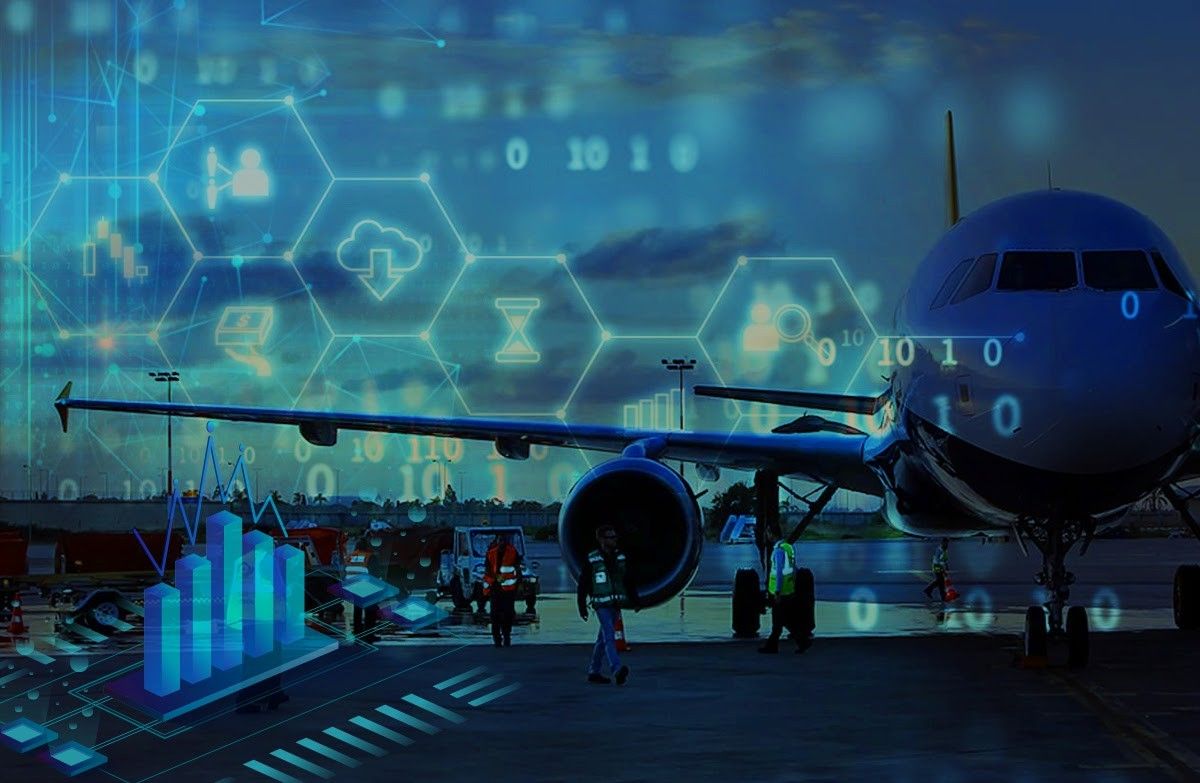Reshape the flying experience with your Airline
The airline industry has been revolutionising the way passengers travel, enabling people to travel to a different part of the world in just a few hours. Being one of the most technologically dependent industries, airlines face a whole complexity of new challenges posed by the dynamic nature of passenger expectations and competition, as well as its business itself. As a result, airlines are committed to exploring novel ways to adopt innovative and emerging technologies in every aspect of their business to create and maintain an edge over their competition.
This article highlights some of the emerging technologies and trends which can be incorporated to reshape flying in the years to come, embracing digital transformation.
Deviation from the legacy processes to the new digital era holds a significant impact to the overall system. As the International Air Transport Association (IATA) states in “Future of the Airline Industry 2035”, cybersecurity, robotics and automation, 3D printing, big data, virtual reality (VR), augmented reality (AR), IoT, new manufacturing techniques, and geospatial technology are some of the advanced technologies that will define the future of the aviation industry. However, to increase customer service, operational efficiency and ticket sales, here are some of the technology trends that hold significant opportunities for airlines.
Artificial Intelligence (AI)
Being a buzz word in the new age of technology, artificial intelligence has been drawing greater attention in the industry over the past decade. It is with no doubt one of the most disruptive and adaptable technologies with its endless possibilities around in air travel. Personalization is one of the core areas which incorporates AI to form the customer strategy in line with their needs.
Personalization has evolved to a stage where it demands to be leveraged, enhancing customer experience at every touchpoint. Optimized digital interactions have led the path for most airlines to retain their passengers to a greater extent. Having said that, to deliver a personalized travel experience starting from the ticket booking stage, having AI chatbots in place on the airline website and mobile apps, which are integrated with reservation systems bring travel experience to new heights for the passengers. Despite its popularity, the maturity of the right application of AI bots is still not fully proven.
The capabilities of chatbots can extend to manage a broader range of tasks through simulated human conversation. It enables passengers to conveniently search for destinations, flight times, details about baggage allowance, adding extra luggage, selecting a seat, booking tickets, online check-in, customer support and much more through a real-time conversation. Customer service itself can be automated and efficiency could be increased while providing a personal assistant for the customers. However, with the ever-growing market demand, the possible application of AI could be looked beyond chatbots. Moving one step further, AI blended with social sentiments derived through social platforms can offer a whole new experience such as personalized campaigns to up-sell and cross-sell demanded flight routes/destinations, fare products, and ancillaries, which will help airlines to maximize revenue while driving transformation in the long term. Launching new destinations and products could be driven through this approach by analysing consumer social sentiment.
The true potential of AI can be further leveraged in inventory management, flight schedule optimization, and almost in all layers of customer service and operational infrastructure. It should be noted that the requirement of domain expertise, creativity, and high cost will always follow the pros of AI. Despite these challenges, early adopters will have a great chance to capitalize on AI with sufficient experience and expertise to step up their technology game.
Big Data and Analytics
A similar issue is faced in customizing the system for each airline’s requirements, be it theme and languages in the B2C/B2B user interfaces or airline-specific workflows in the back-office/administration system. The inflexibility of legacy systems means those introduced more recently, especially from 2000 onward, have an edge in terms of complementing airline strategy through quicker time-to-market. Features could be added to modern PSSs within a few days or even hours, encompassing major airline commercial processes. Therefore when evaluating a new PSS, it is vital that airlines consider the overall architectural flexibility of systems.Big data and Analytics is a breakthrough that presents many opportunities driving the digital transformation of the industry. In recent years applications of Big Data in travel came to the fore with three different types of data available with airlines: customer data, product data, and operational data. The instances that data science disciplines come in handy extends for achieving streamlined maintenance, operational efficiencies, customer service and relationship improvements, improved safety, cost efficiency and much more.
Customer relationship and loyalty can be tapped by big data to strengthen customer values through proactive action. Analyzing big data leads the way in obtaining insights into customer behavior patterns, preferences and purchasing behavior; and predicts potential future demand. In return, tailor-made offers can be easily pushed towards the right customer at the right time with precisely analysed data. The number of variables in each individual’s profile, right from previous purchasing history to itineraries and priorities can be analyzed in a fraction of a second to present custom made offers to passengers. This approach unleashes upselling opportunities such as ancillaries while driving ticket sales.
With the evolution of airline revenue management, there are many areas that could leverage the capabilities of big data and analytics. Inventory control needs to work alongside flight schedule to assign the aircraft capacity for schedules with predicted demand to meet “demand-driven dispatch”. On the other hand, inventory allocation can be optimized with dynamic pricing set in response to market demand. This involves intelligence on market segmentation for pricing with analytics to maximize revenue.
Further, keeping a close relationship with commercial and operations functions of the airline such as pricing, marketing, and scheduling helps the airline to better integrate with its revenue management. For example, promotional campaigns can be better targeted for the right audience with flights and schedule times and differentiate high and low demand seasons, as well as vacation periods.
Having clean, accurate, collated and measurable data is crucial to analyse and respond timely to current and future demands and strategically align airline decision making. Above mentioned illustrates some of the uses of Big Data Analytics in the travel industry, which would provide opportunities for airlines to stand out from the competition. Further, big data and analytics can be utilized in tracking passenger baggage in real-time, predictive aircraft maintenance (Eg: analyse and forecast fuel efficiencies), improving flight safety with weather forecasts and more.
Biometrics
Say no to the era of needing your passport or boarding pass for your authentication. Let your face carry along with your identity with biometrics.

The industry is constantly directing efforts towards making travel experience delightful and convenient for passengers. However, among all other aspects, airports remain on top having greater need to embrace technology to increase efficiencies and streamline their processes. With ever-increasing passenger flows, airports are still struggling in passenger processing especially with regards to passport verification at check-in and boarding, which carries much stress and inefficiencies at many points. Adopting Biometric technology in airports can revolutionize the entire passenger verification process dramatically. The initiatives are already coming to fruition sooner than expected with trial testing ongoing in many major airports.
Biometrics are revolved around facial recognition, retinal scanning and fingerprint authentication. Passenger authentication process could be streamlined incorporating facial biometry which could go one step ahead and let passenger authenticate themselves with their mobile or tablets at terminals, before departure and upon arrival as well. Nowadays the check-in process is stressful, with the time-consuming verification process leading passengers to wait in queues for a long time. One could imagine how far the integration of biometric systems with Departure Control Systems could go into automating border control, check-in, boarding, baggage drop and claim, lounge access, security checks, and migration formalities. The entire verification process could be sped up with more accurate and quicker authentication eliminating wait times, long queues and paperwork, with just a few seconds of screening.
Disruption management is a large area that keeps growing and causes a significant loss in revenue. Flight delays cause serious damage to airline schedules and passenger itineraries. On the other hand, the underlying complexity with flight rescheduling, transferring and rebooking passengers on other available flights often spread in a chain. Biometrics can help in this process by efficiently shifting passengers to the next available aircraft with self-service biometric-enabled services helping airports to restore regular routine swiftly and cost-efficiently.
The possibilities are endless with this technology – imagine how convenient it would be to pay for duty-free shopping simply by facing a camera instead of having to reach for your passport and boarding pass. Adopting biometrics in passenger authentication and verification will ensure a promising experience that is less stressful and more secure.
In Conclusion
Although the above technologies have their own use cases, “Artificial intelligence, Big data analytics, and Biometrics” work hand in hand to transform the airline industry to a tech-savvy and passenger-centric industry. It is with no surprise that emerging technologies keep lifting the aviation industry to new heights by unleashing opportunities to meet passenger expectations, enhancing operational efficiency and ultimately enabling airlines to meet revenue targets. Having said that, airlines should take proactive approaches to incorporate the best fit technologies in the most optimal way to sustain themselves amidst ever-increasing competition and customer demand in the aviation and travel sphere.
This article explored a few technologies and their applications in the aviation industry. Feel free to comment on what you think about the role of AI, Big Data Analytics and Biometrics in the years to come. Avtra will continue to look into the application of more emerging technologies, so stay tuned for Part 2 of this article.

Avtra is all in one integrated PSS platform with in-built schedules management, inventory and ancillary management, pricing management and booking management modules. AvtraSoft Limited itself is a specialist IT provider for the airline industry, providing end to end software solutions for airlines, airports and travel agents. Avtra was born out of the need identified in the aviation domain for innovative purpose-built IT solutions that could support modern carriers. Avtra’s Passenger Service System product is designed from the ground-up to support airlines of any size and operating model (LCC, FCC, Hybrid). Avtra also offers an intuitive Departure Control System (DCS), as well as a Frequent Flyer Programme (FFP) product, alongside ConnectOTA which is a platform for Online Travel Agents to offer services of many airlines and other service providers such as hotels and car rentals. Avtra’s team has a multitude of experience in the Asian, African and Middle East region, from previous engagement with airlines and other travel partners. Avtra’s differentiation stems from the fact that its products are professionally engineered and continuously being innovated upon, while the team accounts for years of experience in the industry and know-how of the market. Read more on Avtra’s products by taking a look at Our Products.





